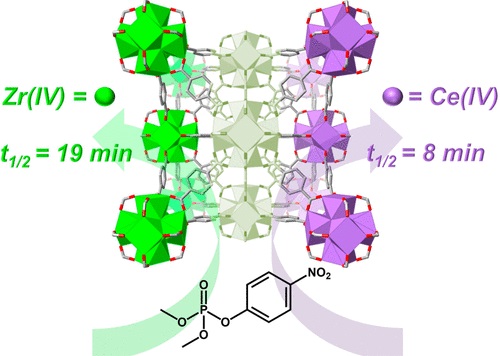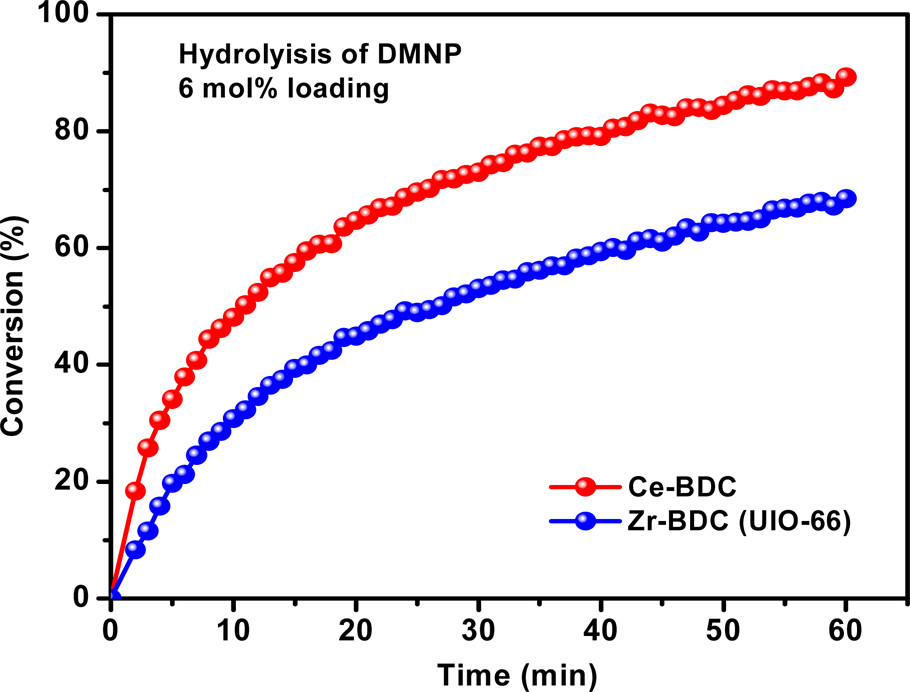Home >
News > Cerium(IV) vs Zirconium(IV) Based Metal−Organic Frameworks for Detoxification of a Nerve Agent
Cerium(IV) vs Zirconium(IV) Based Metal−Organic Frameworks for Detoxification of a Nerve Agent
Summary:
The authors from Northwestern University, U.S. Army Research, Development, and Engineering Command, and King Abdulaziz University developedCe-BDC (a Ce(IV)-based MOF) with high thermal/chemical stability and defect sites, achieving faster hydrolysis of nerve agents (GD) and their simulant (DMNP) than Zr-based UiO-66 in the field of chemical warfare agent (CWA) detoxification.

Background:
1. To address the detoxification of organophosphate nerve agents (CWAs)—which inhibit acetylcholinesterase and cause death—previous researchers used Zr(IV)-based MOFs (e.g., UiO-66, NU-1000) for catalytic hydrolysis, achieving good activity, yet homogeneous Ce(IV) catalysts suffer from polymeric precipitation at pH > 4, limiting their use.
2. The authors proposed synthesizing a Ce(IV)-based MOF (Ce-BDC) with UiO-66 architecture to stabilize Ce(IV) ions, and found it exhibited faster hydrolysis rates for DMNP and GD than Zr-BDC, with further enhancement when combined with PEI (polyethylenimine).
Research Content:
1. Synthesis
-Ce-BDC synthesis: Based on a published method with modifications. BDC (benzene-1,4-dicarboxaldehyde) was dissolved in DMF, mixed with aqueous Ce(NH₄)₂(NO₂)₆, stirred at 100 °C for 30 min, centrifuged, washed with DMF/ethanol (soaked in ethanol overnight), and dried under vacuum (70 °C for 1 h, then 100 °C for 16 h).
-DMNP synthesis: 4-nitrophenol reacted with dimethylchlorophosphate (catalyzed by TiCl₄, triethylamine as base) in anhydrous THF, followed by extraction, drying, and silica gel purification (Hexane:EtOAc = 1:1).
2. Characterizations
1.BET and pore size: Ce-BDC had a BET surface area of 1250 m²/g (comparable to UiO-66); N₂ isotherms and pore size distribution confirmed similar porous structures to UiO-66.
2.SEM tests: Ce-BDC particles were larger than UiO-66 particles.
3.Other tests:
- DRIFTS: The O-H peak of Ce₆ nodes (3646 cm⁻¹) was shifted lower than Zr₆ nodes (3674 cm⁻¹), indicating weaker O-H bonds.
- PXRD: Ce-BDC and UiO-66 had matching crystalline structures (UiO-66 architecture).
- Potentiometric titration: Ce-BDC had ~1.62 missing linkers/node (similar to UiO-66’s 1.6), with pKa values (3.46, 6.86, 8.53) close to UiO-66’s (3.52, 6.79, 8.30).
3. Application
1.DMNP hydrolysis:
- In N-ethylmorpholine buffer (pH 10), Ce-BDC reduced DMNP half-life from 19 min (UiO-66) to 8 min.
- With PEI (optimized loading), Ce-BDC shortened DMNP half-life to 4.5 min (faster than buffer alone).
2.GD hydrolysis: In buffer (pH 10), Ce-BDC achieved a GD half-life of 3 min (faster than UiO-66’s ~4 min).
3.Homogeneous control: Ce(IV)/Zr(IV) solutions showed no significant DMNP hydrolysis (Ce(IV) stopped at ~50% conversion due to precipitation).
4. Mechanism
- Ce(IV)’s 4f orbitals mix with P=O orbitals of organophosphates, forming penta-coordinate intermediates susceptible to nucleophilic attack.
- Ce₆ nodes in Ce-BDC stabilize Ce(IV) (avoiding precipitation) and provide defect sites (active sites for hydrolysis); PEI acts as a heterogeneous buffer, with primary amines enhancing hydrolysis beyond pH control.

Outlook:
This study is the first to demonstrate Ce(IV)-based MOFs for fast nerve agent detoxification, showing superior performance to Zr-based analogues. The Ce-BDC/PEI system eliminates liquid buffers, enabling potential applications in protective suits/masks. Future work will focus on transferring Zr-based MOF optimization strategies to Ce-based systems for further rate enhancement.
Cerium(IV) vs Zirconium(IV) Based Metal−Organic Frameworks for Detoxification of a Nerve Agent
Authors: Timur Islamoglu, Ahmet Atilgan, Su-Young Moon, Gregory W. Peterson, Jared B. DeCoste, Morgan Hall, Joseph T. Hupp, Omar K. Farha
DOI: 10.1021/acs.chemmater.6b04835
Link: https://pubs.acs.org/doi/10.1021/acs.chemmater.6b04835
The above review is for academic progress sharing. For any errors or copyright issues, please contact us for correction or removal.

